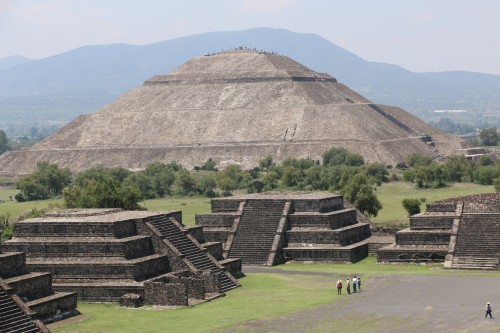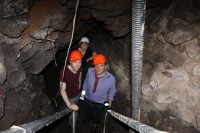By James Dacey in Mexico
Yesterday was day three of the Physics World Mexican adventure and it turned out to be a really exciting 24 hours. Matin Durrani and I visited Teotihuacan – the “City of the Gods”– located 30 miles north-east of Mexico City. We were there to witness some of the closing moments of a 15-year particle physics experiment designed to “see” inside the Sun Pyramid, the world’s third biggest pyramid by volume.
Our guide for the day was the leader of the physics team at Teotihuacan, Arturo Menchaca of the National Autonomous University of Mexico, and we were joined on our adventure by the French astrophysicist Catherine Cesarsky. As our local driver careened through the Mexico City traffic, Arturo used the journey to give a quick PowerPoint presentation on his laptop about the aims of the Teotihuacan project. By the end of that ride I felt pretty nauseated but left the vehicle knowing why archaeologists and physicists are so intensely interested in this ancient Mesoamerican city.
The deserted city of Teotihuacan was discovered by the Aztecs in the 14th century, and archaeological work dates the origins of the city to 100 BC. Current belief is that Teotihuacan was a multi-ethnic site, being home to four distinct groups of people. Among the ancient metropolis are two giant pyramids, the Sun Pyramid (75 m tall, with a base 225 × 225 m) and the slightly smaller Moon Pyramid.
One of the big mysteries about Teotihuacan is why nobody has ever discovered burial places for the leaders of these ancient peoples. Perhaps the obvious location for a tomb would be inside the pyramids as per the Egyptians, but the two major pyramids at Teotihuacan are sealed off with no entrances. There have been fears about the stability of these giant “sandcastles”, so chipping into the pyramids is not really an option. Instead, Menchaca and his team used a technique, developed in the 1960s by University of California at Berkeley physicist Luis Alvarez, of using muons to build an image of the internal structure of the Sun Pyramid. Let me explain how it works.
The Earth’s surface is continuously bathed in showers of muons, produced as secondary radiation when cosmic rays interact with the Earth’s atmosphere. These muons interact very little with air, but they can rapidly lose energy and change direction when interacting with more dense matter. Therefore, placing a muon detector underneath the Sun Pyramid, Menchaca and his team were able to create 2D images of the pyramid’s interior, on the lookout for air pockets that could be burial chambers.
One of the huge strokes of luck in the project is the existence of a 100 m man-made tunnel beneath the Sun Pyramid leading to a clover-shaped cavity almost directly beneath the pyramid’s apex, providing an ideal spot for the muon detector. Apparently, the tunnel was discovered just a few years ago when the dog of a US tourist vanished beneath the pyramid. It led to a search that revealed a partially blocked entrance that was previously assumed to be a natural feature caused by lava flows. Menchaca’s team has been taking measurements at the site since 2000 and the project has come to a close this year, with the detector being removed this week.
Matin, Catherine and I had the privilege of joining Menchaca on his last visit down that narrow tunnel to bid farewell to his detector. We descended a two-flight ladder into the dark narrow tunnel. Immediately we came to appreciate our hard hats as our heads bashed into the low ceiling and jagged features jutting out of the walls. You could see the moisture dripping off the walls, and I felt like a cross between Indiana Jones and Gollum as I crept onwards towards the precious muon detector.
Arriving in the chamber was quite surreal. The muon detector itself was about my height of just under 6 foot tall and the same in width and breadth. It looked something like a pizza oven housed within a garden shed, comprising rectangular detector sheets aligned in shelves with the whole structure was housed inside a metallic chamber. There was a poignant moment when Arturo locked up his shed for the last time and we returned down the tunnel towards the outside world. A little later that day, I returned to the tunnel without Arturo and briefly helped some of the guys to remove part of the detector, a job that will be completed within the next few days.
The million-dollar question of course is did Arturo and his team find anything? He remained pretty tight-lipped on this and says that a final report is due out this year. Reading between the lines though, I got the impression they didn’t manage to collect enough data within the allocated time to reach any firm conclusions. He joked with us that the project has become Mexico’s “cold fusion”, in that it promised so much but the killer breakthrough was always just around the corner.
Much like Luis Alvarez, Menchaca is a scientist bursting with ideas and probably not willing to devote his whole career to just one problem. He has already turned his focus to his next application of “muography”, which is to probe the interior of Popocatépetl, the large active volcano that lurks dangerously 70 km south-east of Mexico City. Following in the footsteps of projects in Japan and Italy, Menchaca will team up with geophysicists to build dynamic images of the volcanic cone to improve the ability to predict eruptions.
In the meantime, the whereabouts of the leaders of Teotihuacan will remain a mystery.


Guidelines
Show/hide formatting guidelines
this text was deletedwhere people live in harmony with nature and animals</q>
Some text